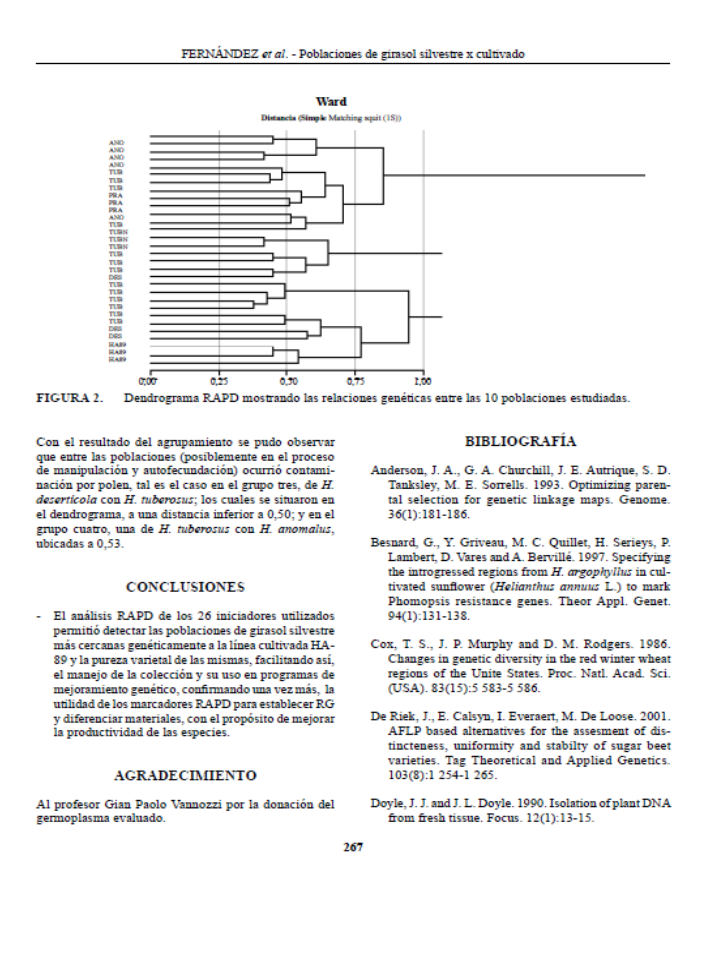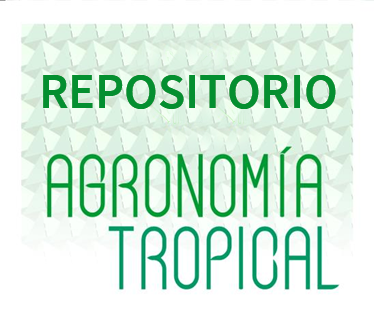Análisis RAPD entre y dentro de poblaciones derivadas de girasol silvestre x cultivado
Resumen
El objetivo de este estudio fue estimar las relaciones genéticas (RG) entre 10 poblaciones generadas mediante cruces de girasol silvestre por la línea cultivada HA-89 utilizándose 26 marcadores RAPD. Se procedió a la siembra de los materiales en invernadero para obtener las hojas jóvenes y sanas, aislándose el ADN según el protocolo de Doyle and Doyle (1990), éste se cuantificó y diluyó a una concentración aproximada de 15 ng.µl-1, luego se amplificó en presencia de la enzima Taq polimerasa con los 30 iniciadores aleatorios decámeros de la compañía Operón Technologies. Los productos de amplificación son separados mediante electroforesis en geles de agarosa al 1,2%, visualizados y analizados con el equipo ChemiDoc-It™, software Quantity One®, para luego construir las matrices binarias (0,1) a partir de las cuales se realizó el análisis estadístico. Para estimar las RG dentro y entre las poblaciones, se utilizó el coeficiente de asociación Simple Matching y las mismas se representaron en un dendrograma construido con el método de Ward, apreciando que la población con pedigrí H. deserticola se ubicó más cerca a la línea cultivada HA-89 y H. anomalus resultó ser la más distante.
Descargas
Citas
• Besnard, G., Y. Griveau, M. C. Quillet, H. Serieys, P. Lambert, D. Vares and A. Bervillé. 1997. Specifying the introgressed regions from H. argophyllus in cultivated sunflower (Helianthus annuus L.) to mark Phomopsis resistance genes. Theor Appl. Genet. 94(1):131-138.
• Cox, T. S., J. P. Murphy and D. M. Rodgers. 1986. Changes in genetic diversity in the red winter wheat regions of the Unite States. Proc. Natl. Acad. Sci. (USA). 83(15):5 583-5 586.
• De Riek, J., E. Calsyn, I. Everaert, M. De Loose. 2001. AFLP based alternatives for the assesment of distincteness, uniformity and stability of sugar beet varieties. Tag Theoretical and Applied Genetics. 103(8):1 254-1 265.
• Doyle, J. J. and J. L. Doyle. 1990. isolation of plant DNA from fresh tissue. Focus. 12(1):13-15.
• Encheva, J., H. Köhler, M. Christov and W. Friedt. 2005. intergeneric hybrids between cultivated sunflower (Helianthus annuus L.) and Verbesina helianthoides (GENUS Verbesina)-RAPD Analysis. Helia. 28(42):37-44.
• Exeter Software. 2000. NTSYSpc ver.2.20. Applied Biostatistics.
• Fernández, H. y E. Soto 1998. The present status and prospects for sunflower in Venezuela Helia, 21(29):137-144.
• Fick, G. and J. Miller 1997. Sunflower breeding, In: Sunflower technology and production. (ed. A. Schneiter) ASA-CSSA-SSSA. (15):395-439.
• Hunter, R. B. 1989. ASTA approach on minimum distance. In: Wilkinson D (ed.) Proc 44th Annual Corn Sorghum Industry. Res. Conf. 44:193-195.
• InfoStat, 2004. Versión 2004. Manual del usuario, 1ª ed. Córdoba, Argentina.
• InfoStat, 2007. Versión 2007p. Grupo InfoStat, FCA, Universidad Nacional de Córdoba, Argentina.
• Jan, C. C. 1997. Cytology and interspecific hybridization. In: Sunflower technology and production. ASA-CSSA-SSSA. Madison. 497-558 pp.
• Laferrière, J. E. 1986. interspecific hybridization in sunflowers: an illustration of the importance of wild genetic resources in plant breeding. Outlook on Agriculture. 15:104-129.
• Laurentin, H. 2009. Data analysis for molecular characterization of plant genetic resources. Genet. Resour. Crop. Evol. 56:277-292.
• Lawson, W. R., K. C. Goulter, R. J. Henry, G. A. Kong and J. K. Kochman. 1998. Marker-assisted selection for two rust resistance genes in sunflower. Mol. Breed. 4:227-234.
• Leclercq, P. 1969. Une stérilité male cytoplasmique chez le tournesol. Ann. Amelior. Plant. 19:99-106.
• Liu, J., G. S. Liu and C. C. Jan. 2003. Comparison of genetic diversity of the germplasm resources of confectionary sunflower (Helianthus annuus L.) in China based on RAPDs and AFLPs. Acta Bot. Sinica. 45(3):352-358.
• Lu. Y. H., A. D’Hont, F. Paulet, L. Grivet, M. Arnaud and J. C. Glaszmann. 1994. Molecular diversity and genome structure in modern sugarcane varieties. Euphytica. 78:217-226.
• Malécot G. 1948. Les mathématiques de l’hérédité. Paris: Masson and Cie.
• Mantel, N. A. 1967. The detection of disease clustering and a generalized regression approach. Cancer Res., 27(2):209-220.
• Messmer, M. M., A. E. Melchinger, R. Herman and J. GyBoppenmayer. 1993. Relationship among early European maize inbreds: II: Comparison of pedigree with RFLP data, Crop Science, 33:944-950.
• Nandini, R. and J. N. Chikkadevaiak. 2005. DNA Fingerprinting of sunflower genotypes (Helianthus annuus L.). Helia. 28(42):9-18.
• Nei, M. 1978. Estimation of average heterozygosity and genetic distance from a small number of individuals. Genetics. 89(3):583-590.
• Pankovic, D., M. Mihaljcevic and D. Skoric.1997. Determination of genetic distance between different sunflower lines with RAPD markers. In: I Symposium on molecular genetics and I Symposium on mutagenesis and genotoxicology. Zlatibor, Yugoslavia. 34 p.
• Pérez-Almeida, I., S. Vásquez, D. Pérez y E. Salazar. 2010. Diversidad genética en seis especies de Passiflora spp. utilizando RAPD. Rev. Fac. Agron. 27:347-359.
• Powell, W., M. Morgante, C. Andre, M. Hanafey, J. Vogel, S. Tingey and A. Rafalski. 1996. The comparison of RFLP, RAPD, AFLP and SSR (microsatellite) markers for germplasm analysis. Molecular Breeding. 2(3):225-238.
• Rieseberg, L. H., A. M. Desrochers and S. J Young. 1995. interspecific pollen competition as a reproductive barrier between sympatric species of Helianthus (Asteraceae). Am. J. Bot. 82(4):515-519.
• Rieseberg, L. H. 1996. Homology among RAPD fragments in interspecific comparisons. Molecular Ecology. 5:99-105.
• Roldán-Ruiz, I., J. Dendauw, E. Van Bocktaele, A. Depicke and M. De Loose. 2000. AFLP markers reveal high polymorphic rates in ryegrass (Lolium spp.). Mol. Breed. 6:125-134.
• Salazar, B., H. Laurentin, M. Davila and M. Castillo. 2006. Reliability of the RAPD technique for germplasm analysis of sesame (Sesamum indicum L.) from Venezuela. Interciencia. 31(6):456-4.
• Seiler, G. J. 1991. Registration of six interspecific sunflower germplasm lines derived from wild perennial species. Crop Sci. 31:1097-1098.
• Seiler, G. J. 1992. Utilization of wild sunflower species for the improvement of cultivated sunflower. Field Crops Res. 30(3-4):195-230.
• Seiler, G. J. 1993. Registration of six interspecific germplasm lines derived from wild perennials sunflower. Crop Sci. 33:1 110-1 111.
• Seiler, G. J. 2007. Wild annual Helianthus anomalus and H. deserticola for improving oil content and quality in sunflower. industrial crops products. 25(1):95-100.
• Seiler, G. J. 2010. Utilization of wild Helianthus species in breeding for disease resistance. Proceedings of the International Symposium: “Sunflower breeding on resistance to disease”, Krasnodar, Russia. 36 p.
• Sokal, R. R. y F. J. Rohlf. 1994. Biometría: los principios y la práctica de la estadística en la investigación biológica. 3ra ed. Nueva York: Freeman.
• Sokal, R. R. and C. D. Michener. 1958. A statistical method for evaluating systematic relationships. Univ. Kansas Aci. Bull. 38:1 409-1 438.
• Soto, E. y H. Fernández. 1997. El girasol en Venezuela. Fonaiap Divulga. N° 56, Abril-Junio. Maracay, estado Aragua. Venezuela.
• Soto, E. 2005. El cultivo del girasol en Venezuela. Revista Digital Ceniap Hoy, N° 9. Septiembre-Diciembre. Maracay, estado Aragua. Venezuela.





